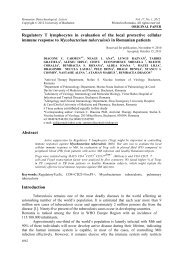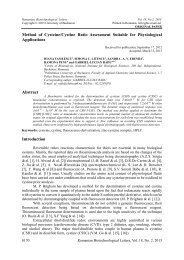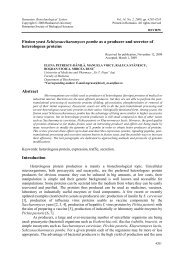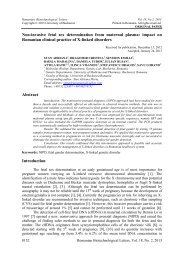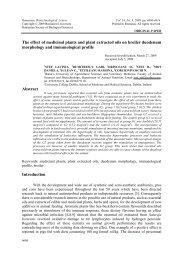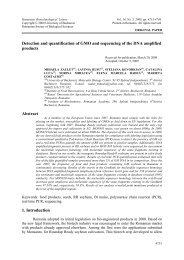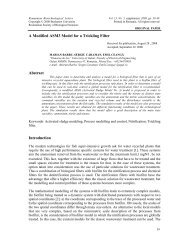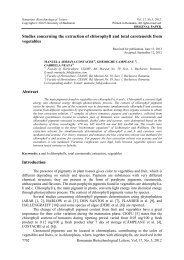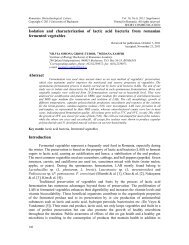In vitro antibacterial activity of essential oils from plant ... - Rombio.eu
In vitro antibacterial activity of essential oils from plant ... - Rombio.eu
In vitro antibacterial activity of essential oils from plant ... - Rombio.eu
- No tags were found...
You also want an ePaper? Increase the reach of your titles
YUMPU automatically turns print PDFs into web optimized ePapers that Google loves.
Romanian Biotechnological Letters Vol. 16, No. 2, 2011Copyright © 2011 University <strong>of</strong> BucharestPrinted in Romania. All rights reservedORIGINAL PAPER<strong>In</strong> <strong>vitro</strong> <strong>antibacterial</strong> <strong>activity</strong> <strong>of</strong> <strong>essential</strong> <strong>oils</strong> <strong>from</strong> <strong>plant</strong> family LamiaceaeReceived for publication, May 5, 2010Accepted, March 8, 2011LEVIĆ JOVANKA 1 , ČABARKAPA IVANA 1 , TODOROVIĆ GORAN 2 , PAVKOVSAVA 2 , SREDANOVIĆ SLAVICA 1 , COGHILL-GALONJA TAMARA 3 ,KOSTADINOVIĆ LJILJANA 31 <strong>In</strong>stitute for Food Technology, Novi Sad, Bulevar cara Lazara 1, SerbiaTel/Fax: 38121 450-781; E-mail: jovanka.levic@fins.uns.ac.rs2 <strong>In</strong>stitute for Medicinal Plant Research „Dr. Josif Pančić“, Belgrade, Tad<strong>eu</strong>ša Košćuška 1,Serbia3 Faculty <strong>of</strong> Bi<strong>of</strong>arming, Bačka Topola, M. Tita 39, SerbiaAbstractMedicinal <strong>plant</strong>s and herbs have been used for many years in treating various animal andhuman diseases. Secondary metabolites <strong>from</strong> medicinal <strong>plant</strong>s are widely unexploited in 'conventional'animal production systems. The aim <strong>of</strong> the investigation was to study antimicrobial activities <strong>of</strong> three<strong>essential</strong> <strong>oils</strong> on five bacterial species (Escherichia coli, Salmonella choleraesuis, Prot<strong>eu</strong>s mirabilis,Staphylococcus aur<strong>eu</strong>s, Enterococcus faecalis) obtained <strong>from</strong> the American Type Culture Collection.The <strong>plant</strong>s used in this study were oregano (Origanum vulgare L.), thyme (Thymus vulgaris L.) and wildthyme (Thymus serpyllum L.), all members <strong>of</strong> Lamiaceae family. The <strong>antibacterial</strong> <strong>activity</strong> <strong>of</strong> <strong>essential</strong><strong>oils</strong> was tested by disc diffusion method and broth micro-dilution susceptibility assay, according to theNational Committee for Clinical Laboratory Standards Guidelines. All the tested <strong>oils</strong> demonstratedantimicrobial <strong>activity</strong> on used bacterial strains.The analysis <strong>of</strong> variance revealed that there were highly significant differences (P
LEVIĆ JOVANKA, ČABARKAPA IVANA, TODOROVIĆ GORAN, PAVKOV SAVA,SREDANOVIĆ SLAVICA , COGHILL-GALONJA TAMARA, KOSTADINOVIĆ LJILJANAinterest in evaluating natural alternatives for currently used antibiotics is increasingworldwide.Medicinal <strong>plant</strong>s and herbs have been used for many years in treatments <strong>of</strong> variousanimal and human diseases. Nowadays, <strong>plant</strong> extracts are more popular as animal feedsupplements because most <strong>of</strong> the antimicrobial growth promoters in animal feed have beenbanned due to their residual effects. They act as <strong>antibacterial</strong>, antioxidant, anticarcinogenic,antifungal, analgesic, insecticidal, anticoccidial agents as well as growth promoters (TIPU &al. [6]). Medicinal <strong>plant</strong>s have become the focus <strong>of</strong> intense study in terms <strong>of</strong> validation <strong>of</strong>their traditional uses through the determination <strong>of</strong> their actual pharmacological effects(BHASKARWAR & al. [7]).Among the aromatic <strong>plant</strong> species <strong>from</strong> family Lamiaceae (Labiateae), generaOriganum and Thymus have a special position. Their <strong>essential</strong> <strong>oils</strong> are known to exhibitantimicrobial activities on bacteria (DORMAN & DEANS, [8]; SKANDAMIS & al. [9]).This is basically due to their major components being carvacrol and thymol, which act aspreservatives (ULTEE & al. [10], BURT [11]). The biological <strong>activity</strong> <strong>of</strong> <strong>essential</strong> <strong>oils</strong>depends on their chemical composition, which is determined by genotype and influenced byenvironmental and agronomic conditions (BURT [11]). Thymol and carvacrol do not exhibitadverse effects on human health, and are proven not to cause either significant or marginaltoxic effects at cellular level. Also, the concentrations at which they exhibit antimicrobialactivities are not at possible genotoxic level (STAMMATI & al. [12]; BURT [11]).The chemical analysis <strong>of</strong> the oregano (Origanum vulgare L.) <strong>essential</strong> oil revealed thepresence <strong>of</strong> several ingredients, most <strong>of</strong> them having important antioxidant and antimicrobialproperties (OZKAN & al. [20]). Carvacrol and thymol, the two main phenols that constituteabout 78–85% <strong>of</strong> oregano oil, are mainly responsible for the antimicrobial <strong>activity</strong> <strong>of</strong> the oil(KOKKINI & al. [13]). <strong>In</strong> addition, other minor constituents such as monoterpenehydrocarbons, γ-terpinene and p-cymene also contribute to <strong>antibacterial</strong> <strong>activity</strong> <strong>of</strong> the oil(BURT [11]).Essential oil <strong>of</strong> thyme (Thymus vulgaris L.) contains more than 60 ingredients withimportant antioxidant and antimicrobial properties (BARANAUSKIENE & al. [15]). Themost important compounds <strong>of</strong> thyme <strong>essential</strong> oil are two phenols: thymol (44–60%) andcarvacrol (2.2–4.2%) that are major and more active than monoterpene hydrocarbons p-cymene (18.5–23.5%) and γ-terpinene (16.1–18.9%), (DI BARANAUSKIENE & al. [15];PASQUA & al. [16]; DAFERERA & al. [17]). <strong>In</strong> <strong>vitro</strong> studies showed that these compoundsexpress their antimicrobial <strong>activity</strong> on a broad spectrum <strong>of</strong> Gram-negative and Gram-positivebacteria (BURT& al. [18]; OZCAN & al. [13]).According to J. Passet, the chemotypes <strong>of</strong> T. vulgaris are thymol, carvacrol, linalol, α-terpineol/terpinyl acetate, geraniol/geranyl acetate, and trans-4-tuyenol. Besides those sixmain chemotypes, there are also p-cimen, limonene and 1,8 cineole. T. serpyllum containsthymol, carvacrol, linalol and geraniol (MARKOVIC, [19]).This paper presents the results <strong>of</strong> the antimicrobial <strong>activity</strong> <strong>of</strong> <strong>essential</strong> <strong>oils</strong> <strong>from</strong>oregano (Origanum vulgare L.), thyme (Thymus vulgaris L.), and wild thyme (Thymusserpillum L.) on five important pathogenic bacteria. The aim <strong>of</strong> the study was to compare theeffectiveness <strong>of</strong> different concentrations <strong>of</strong> the <strong>essential</strong> <strong>oils</strong> on pathogenic microorganisms.Material and methodsThe <strong>plant</strong>s used in this study were: oregano-E 1 (Origanum vulgare L.), wild thyme-E 2(Thymus serpyllum L.) and thyme-E 3 (Thymus vulgaris L.) <strong>from</strong> family Lamiaceae. All <strong>plant</strong>sRomanian Biotechnological Letters, Vol. 16, No. 2, 2011 6035
<strong>In</strong> <strong>vitro</strong> <strong>antibacterial</strong> <strong>activity</strong> <strong>of</strong> <strong>essential</strong> <strong>oils</strong> <strong>from</strong> <strong>plant</strong> family Lamiaceaewere obtained <strong>from</strong> the <strong>In</strong>stitute for Medicinal Plant Research “Dr Josif Pančić”, Belgrade,Serbia.The <strong>essential</strong> <strong>oils</strong> were isolated <strong>from</strong> dried <strong>plant</strong> material by hydro-distillationaccording to the standard procedure reported in the Sixth European Pharmacopeia, [20]. Thedistillation was performed using Clevenger type apparatus, for 2 hours.The antimicrobial <strong>activity</strong> <strong>of</strong> <strong>essential</strong> oil was evaluated using laboratory controlstrains, Escherichia coli ATCC 1053, Salmonella choleraesuis ATCC 10708, Prot<strong>eu</strong>smirabilis ATCC 12453, Staphylococcus aur<strong>eu</strong>s ATCC 11632 and Enterococcus faecalisATCC 14506, obtained <strong>from</strong> the American Type Culture Collection.Antibacterial <strong>activity</strong> <strong>of</strong> <strong>essential</strong> <strong>oils</strong> was tested by the disc diffusion methodaccording to the National Committee for Clinical Laboratory Standards Guidelines. Thismethod is presented as a consensus standard by the NCCLS (National Committee for ClinicalLaboratory Standards, 1999) [21]. Essential <strong>oils</strong> were diluted in propylene-glycol (2-(2-hydroxypropoxy)-1-propanol) to the test concentration ranging <strong>from</strong> 500 to 2 µl/ml.Antimicrobial tests were carried out by the disc diffusion method using 100 μl <strong>of</strong> suspensioncontaining 2.0 x 10 8 CFU/ml <strong>of</strong> bacteria spread on Mueller-Hinton agar (MHA, Himedia) insterilized Petri dishes (90 mm diameter). The discs (6 mm in diameter) were impregnated with10 μl <strong>of</strong> the oil dilution in concentration range <strong>from</strong> 500 to2 µl/ml and placed onto theinoculated agar. Negative controls were prepared using the same solvents to dissolve the<strong>essential</strong> oil propylene-glycol (2-(2-hydroxypropoxy)-1-propanol). The diameters <strong>of</strong> theinhibition zones were measured in millimeters. Experiments were performed in triplicate. Theeffectiveness was classified according to the size <strong>of</strong> zones <strong>of</strong> inhibition measured as: stronglyinhibitory (more than 20 mm inhibition zone), moderately inhibitory (20-12 mm inhibitionzone) and with no inhibitory effect (less than 12 mm zone), according to Rusenova(RUSENOVA & al. [22]).Broth microdilution method was used to determine the minimum inhibitoryconcentration (MIC) and minimum bactericidal concentration (MBC) according to theNational Committee for Clinical Laboratory Standards (NCCLS, [23]). The bacterialinoculates were prepared using overnight cultures and suspensions were adjusted to 0.5McFarland standard turbidity using (the company’s name) turbidimeter.All tests were performed in Mueller Hinton broth. The aliquots <strong>of</strong> 20 µl <strong>of</strong> the<strong>essential</strong> <strong>oils</strong> were added into each well <strong>of</strong> the 96-well microtitre plate, in geometric dilutionsranging <strong>from</strong> 500 to 2 µl/ml. Then, aliquots <strong>of</strong> 160 µl <strong>of</strong> MHB were added. As the final step,20 µl <strong>of</strong> 2×10 6 CFU/ml (according to 0.5 Mc Farland turbidity standards) <strong>of</strong> standardizedmicroorganisms suspensions were inoculated into each well <strong>of</strong> the microplate. The test wasperformed in a volume <strong>of</strong> 200 µl with final <strong>essential</strong> <strong>oils</strong> concentrations <strong>of</strong> 50 to 0.2 µl/ml.Plates were incubated at 37 °C, for 24 hours. The same tests were performed simultaneouslyfor growth control (MHB + tested microrganism) and sterility control (MHB + tested oil).The MIC was defined as the lowest concentration <strong>of</strong> <strong>essential</strong> oil at whichmicroorganisms show no visible growth. Referring to the results <strong>of</strong> the MIC assay, the wellsshowing complete absence <strong>of</strong> growth were identified and 5 µl solutions <strong>from</strong> each well wastransferred to agar plates (NA-nutrient agar, Torlak) and incubated at 37 °C, for 24 hours. TheMBC is defined as the lowest concentration <strong>of</strong> the <strong>essential</strong> oil at which inoculatedmicroorganisms were 99.9% killed.Descriptive and analytical statistics was carried out in the statistical package SPSS10.0 for Windows, significant difference between the calculated mean values <strong>of</strong> the studiedfactors (<strong>essential</strong> oil and concentration) was tested using analysis <strong>of</strong> variance (ANOVA) forfactorial experiments. Statistical significance was calculated using the F-test and LSD test forsignificance threshold <strong>of</strong> 5% and 1%.6036 Romanian Biotechnological Letters, Vol. 16, No. 2, 2011
LEVIĆ JOVANKA, ČABARKAPA IVANA, TODOROVIĆ GORAN, PAVKOV SAVA,SREDANOVIĆ SLAVICA , COGHILL-GALONJA TAMARA, KOSTADINOVIĆ LJILJANAResults and discussionThe analysis <strong>of</strong> variance revealed very significant differences (P
<strong>In</strong> <strong>vitro</strong> <strong>antibacterial</strong> <strong>activity</strong> <strong>of</strong> <strong>essential</strong> <strong>oils</strong> <strong>from</strong> <strong>plant</strong> family LamiaceaeAll tested strains showed lower susceptibility on the <strong>essential</strong> oil <strong>of</strong> wild thyme. Wildthyme oil was efficient in the following range <strong>of</strong> concentration MIC/MBC=3.125-6.25/6.25-12.5 µl/ml for Gram-positive bacteria used, while it only showed an effect at concentrationsMIC/MBC=1.56/3.125 µl/ml for Gram-negative bacterial strains (Table 4).Table 4. Minimal inhibitory concentrations (MIC) and minimum bactericidal concentrations (MBC) <strong>of</strong> <strong>essential</strong><strong>oils</strong> (μl/ml)Test microorganismOregano oil Thyme oil Wild thyme oilMIC MBC MIC MBC MIC MBCP. mirabillis 0.39 0.78 0.39 0.78 1.56E. coli 0.39 0.78 1.56S. choleraesuis 0.39 0.78 1.563.1253.125 1.56 3.1253.125 1.56 3.125S. aur<strong>eu</strong>s 0.78 1.56 3.125 6.25 3.125 6.25E. faecalis 0.78 1.56 6.25 6.25 6.25 12.5Many studies have shown that the <strong>essential</strong> <strong>oils</strong> <strong>of</strong> the herbs oregano and thyme wereeffective against strains <strong>of</strong> E. coli, Salmonella enteritidis, Salmonella choleraesuis andSalmonella typhimurium and that is based upon their high contents <strong>of</strong> thymol and carvacrol,p-cimen and γ-terpinen (SANTOYO & al.[25]; BENNIS & al. [26]; NOSTRO & al. [27];BEN ARFA & al. [28]; KRIST & al.[29]). Carvacrol and thymol are able to disintegrate theouter membrane <strong>of</strong> Gram-negative bacteria, releasing lipopolysaccharides and increasing thepermeability <strong>of</strong> the cytoplasmic membrane to ATP and depolarize the cytoplasmic membrane(XU & al. [30]).<strong>In</strong> the previous studies, the <strong>essential</strong> <strong>oils</strong> <strong>of</strong> oregano were active against E. coli,Salmonella typhimurium, and S. aur<strong>eu</strong>s at the concentration <strong>of</strong> 0.5-1.2 µl/ml (BURT, [11]).Essential oil <strong>of</strong> thyme was active against E.coli, Salmonella typhimurium, and S. aur<strong>eu</strong>s in thefollowing range <strong>of</strong> concentrations 0.45-1.25, 0.45->20, 0.2-2.5 (µl/ml), respectively (BURT,[11]). It appears that the difference in <strong>antibacterial</strong> activities may be related to theconcentration and nature <strong>of</strong> contents, the functional groups, the structural configuration <strong>of</strong> thecomponents and their possible synergistic interaction. These differences found between<strong>essential</strong> <strong>oils</strong> are due to ecological and <strong>plant</strong> growth factors.6038 Romanian Biotechnological Letters, Vol. 16, No. 2, 2011
LEVIĆ JOVANKA, ČABARKAPA IVANA, TODOROVIĆ GORAN, PAVKOV SAVA,SREDANOVIĆ SLAVICA , COGHILL-GALONJA TAMARA, KOSTADINOVIĆ LJILJANATable 2. The effect <strong>of</strong> <strong>essential</strong> <strong>oils</strong> (E), their concentrations (C) and combination <strong>of</strong> those two parameters (ExC)on the bacterial strains tested Prot<strong>eu</strong>s mirabilis ATCC 12453, Escherichia coli ATCC 1053 and Salmonellacholeraesuis ATCC 10708.Concentration Prot<strong>eu</strong>s mirabilis Escherichia coli Salmonella(µl/ml)AverageAverage choleraesuis AverageE 1 E 2 E 3E 1 E 2 E 3E 1 E 2 E 3500 49.7 24.0 34.7 36.1 46.7 24.3 39.0 36.7 42.7 20.0 42.3 35.0250 44.3 21.0 31.7 32.3 43.7 20.3 34.3 32.8 39.3 19.7 42.0 33.7125 38.7 18.7 21.7 26.3 37.0 18.3 30.0 28.4 28.0 18.0 27.7 24.662.5 20.7 18.3 20.3 19.8 22.3 17.0 20.0 19.8 19.0 18.0 20.0 19.031.2 18.0 18.0 12.7 16.2 19.3 16.3 14.7 16.8 18.0 16.7 14.7 16.415.6 13.3 15.7 11.7 13.6 13.3 15.7 13.0 14.0 17.0 15.7 13.3 15.37.8 11.7 14.0 11.0 12.2 12.7 14.7 12.0 13.1 12.7 11.7 12.3 12.23.9 11.3 13.7 10.7 11.9 11.7 12.7 10.3 11.6 12.0 10.3 11.7 11.32.0 11.3 12.3 10.3 11.3 9.7 13.0 10.0 10.9 10.0 10.3 10.3 10.2Average 24.3 17.3 18.3 24.0 16.9 20.4 22.1 15.6 21.6Lsd 0.05 (E) 0.75 0.85 0.71Lsd 0.01 (E) 1.01 1.12 0.94Lsd 0.05 (C) 1.30 1.46 1.23Lsd 0.01 (C) 1.74 1.95 1.64Lsd 0.05 (ExC) 2.26 2.53 2.13Lsd 0.01 (ExC) 3.01 3.38 2.83E 1 – oregano oil (Origanum vulgare L.), E 2 - thyme oil (Thymus vulgaris L.) and E 3 – wild thyme oil (Thymusserpyllum L.)Least significant difference test (Lsd 0.05 and Lsd 0.01 )Table 3. The effect <strong>of</strong> <strong>essential</strong> <strong>oils</strong> (E), their concentrations (C) and combination <strong>of</strong> those two parameters (ExC)on the Staphylococcus aur<strong>eu</strong>s ATCC 11632 and Enterococcus faecalis ATCC14506Concentration Staphylococcus aur<strong>eu</strong>sEnterococcus faecalis(µl/ml) E 1 E 2 E 3 Average E 1 E 2 E 3 Average500 56.0 33.7 44.3 44.7 37.0 21.0 28.7 28.9250 54.0 30.3 40.3 41.6 34.3 19.3 25.7 26.4125 43.3 28.3 30.3 34.0 27.0 16.3 17.7 20.362.5 30.0 16.7 24.3 23.7 18.0 14.3 16.3 16.231.2 19.7 13.7 13.3 15.6 13.3 12.3 15.3 13.715.6 13.3 11.7 12.0 12.3 11.3 11.7 12.0 11.77.8 12.3 10.3 11.3 11.3 10.7 10.7 10.7 10.73.9 12.0 10.0 10.0 10.7 10.3 0.0 10.0 6.82.0 10.0 0.0 0.0 3.3 0.0 0.0 0.0 0.0Average 27.8 17.2 20.7 18.0 11.7 15.1Lsd 0.05 (E) 0.62 0.69Lsd 0.01 (E) 0.82 0.93Lsd 0.05 (C) 1.07 1.20Lsd 0.01 (C) 1.42 1.60Lsd 0.05 (ExC) 1.85 2.08Lsd 0.01 (ExC) 2.45 2.78E 1 – oregano oil (Origanum vulgare L.), E 2 -wild thyme oil (Thymus serpyllum L.) and E 3 – thyme oil (Thymusvulgaris L.)Least significant difference test (Lsd 0.05 and Lsd 0.01 )Romanian Biotechnological Letters, Vol. 16, No. 2, 2011 6039
<strong>In</strong> <strong>vitro</strong> <strong>antibacterial</strong> <strong>activity</strong> <strong>of</strong> <strong>essential</strong> <strong>oils</strong> <strong>from</strong> <strong>plant</strong> family LamiaceaeConclusionsThe analysis <strong>of</strong> variance revealed very significant differences (P
LEVIĆ JOVANKA, ČABARKAPA IVANA, TODOROVIĆ GORAN, PAVKOV SAVA,SREDANOVIĆ SLAVICA , COGHILL-GALONJA TAMARA, KOSTADINOVIĆ LJILJANA16. R. DI PASQUA, V. DE FEO, F. VILLANI, G. MAURIELLO, <strong>In</strong> <strong>vitro</strong> antimicrobial <strong>activity</strong> <strong>of</strong> <strong>essential</strong><strong>oils</strong> <strong>from</strong> Mediterranean Apiaceae, Verbenaceae and Lamiaceae against foodborne pathogens andspoilage bacteria. Annals in Microbiology, 55, 139–143 (2005).17. D.J. DAFERERA, B.N. ZIOGAS, M.G. POLISSIOU, GC–MS analysis <strong>of</strong> <strong>essential</strong> <strong>oils</strong> <strong>from</strong> someGreek aromatic <strong>plant</strong>s and their fungitoxicity on Penicillium digitatum. Journal <strong>of</strong> Agriculture and FoodChemistry, 48, 2576–2581 (2000).18. S. A BURT, R. R. VLIELANDER, P.H. HAAGSMAN, J.A.E VELDHUIZEN, <strong>In</strong>crease in <strong>activity</strong> <strong>of</strong><strong>essential</strong> oil components carvacrol and thymol against Escherichia coli O157:H7 by addition <strong>of</strong> foodstabilizers. Journal <strong>of</strong> food protection, 68, 919-926 (2005).19. S. MARKOVIĆ, Fitoaromoterapija: monografije esencijalnih ulja i ljekovitih biljaka: temeljifitoaromoterapije. 1 th Ed. Centar Cedus. Zagreb, 2005,193-197.20. EUROPEAN PHARMACOPOEIA 6 TH ED., STRASBOURG, COUNCIL OF EUROPE, 2008..21. NCCLS (National Committee for Clinical Laboratory Standards), Performance standards forantimicrobial susceptibility testing; ninth informational supplement. Wayne, Pennsylvania documentM100-S9, Vol.19. No.1, Table 2I.1999.22. N. RUSENOVA, P. PARVANOV, Antimicrobial activities <strong>of</strong> twelve <strong>essential</strong> <strong>oils</strong> againstmicroorganisms <strong>of</strong> veterinary importance. Trakia Journal <strong>of</strong> Sciences, 7 (1), 37-43 (2009).23. NCCLS (National Committee for Clinical Laboratory Standards) Methods for dilution antimicrobialsusceptibility tests for bacteria that grow aerobically. Approved Standard, M7-A5. 2000.24. J. L. GRIFFIN, D. N. MARKHAM, An agar dilution method for the determination <strong>of</strong> the minimuminhibitory concentration <strong>of</strong> <strong>essential</strong> <strong>oils</strong>. Journal <strong>of</strong> Essential Oils Research, 12, 42, 249 (2000).25. S. SANTOYO, S. CAVERO, L. JAIME, E. IBAÑEZ, F.J. SEÑORÁNS, G. REGLER, Supercriticalcarbon dioxide extraction <strong>of</strong> compounds with antimicrobial <strong>activity</strong> <strong>from</strong> Origanum vulgare L.determination <strong>of</strong> optimal extraction parameters. Journal <strong>of</strong> Food Protect, 69 (2) 369-75 (2006).26. S. BENNIS, F. CHAMI, N. CHAMI, T. BOUCHIKHI, A. REMMAL, Surface alteration <strong>of</strong>Saccharomyces cerevisiae induced by thymol and <strong>eu</strong>genol. Letters in Applied Microbiology, 38, 454-458(2004).27. A. NOSTRO, A.R. BLANCO, M.A. CANNATELLI, V. ENEA, G.FLAMINI, I. MORELLI, A. S.ROCCARO, V. ALONZO, Susceptibility <strong>of</strong> methicillin-resistant staphylococci to oregano <strong>essential</strong> oil,carvacrol and thymol. FEMS Microbiology Letters, 230, 191-195 (2004).28. A. BEN ARFA, S. COMBES, L. PREZIOSI-BELLOY, N. GONTARD, P. CHALIER, Antibacterial<strong>activity</strong> <strong>of</strong> selected <strong>plant</strong> <strong>essential</strong> <strong>oils</strong> against Escherichia coli O157:H7, Letters in AppliedMicrobiology, 43, 149–154 (2006).29. S. KRIST, L. HALWACHS, G. SALLABERGER, G. BUCHBAUER, Effects <strong>of</strong> scents on airbornemicrobes, part I thymol, <strong>eu</strong>genol, trans-cinnamaldehyde and linalool. Flavour and Fragrance Journal,22, 44-48 (2007).30. J. XU, F. ZHOU, B.P. JI, R.S. PEI, N. XU, Carvacrol and thymol had desired antimicrobial effect on E.coli. The <strong>antibacterial</strong> effects were attributed to their ability to permeabilize and depolarize thecytoplasmatic membrane. Lett. Appl. Microbiol. 47, 174-179 (2008).Romanian Biotechnological Letters, Vol. 16, No. 2, 2011 6041



